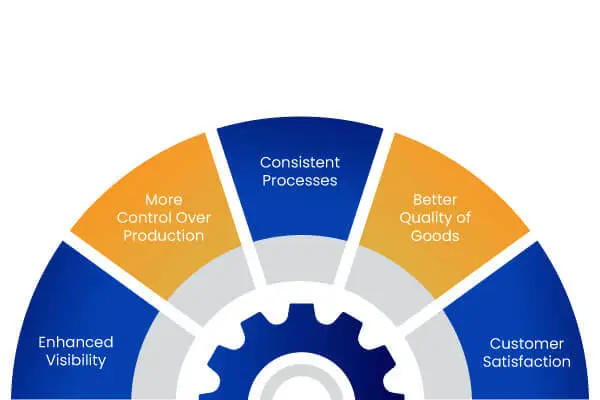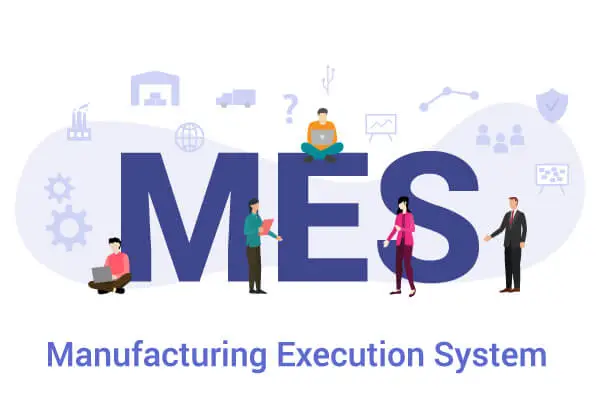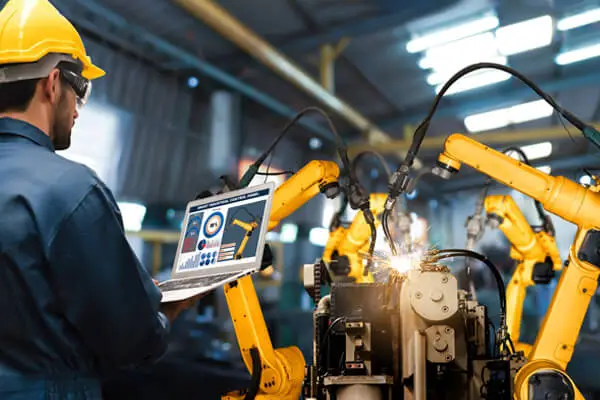Improving Operational Efficiency with MES: A Deep Dive into its Benefits
Table of content Real-Time Visibility and ControlEnhanced Production Planning and SchedulingImproved Quality Control and TraceabilityStreamlined Inventory ManagementData-Driven Decision Making and Continuous ImprovementEnhanced Compliance and Regulatory Compliance Conclusion Operational effectiveness is crucial for companies trying to stay ahead in today’s cutthroat manufacturing environment. Manufacturing Execution Systems (MES) have changed the game by allowing producers to enhance production, streamline operations, and increase efficiency. This article thoroughly explores MES and explains how it can increase operational effectiveness in an organization. Manufacturers can use the power of MES to drive radical changes in their production processes by identifying and acknowledging the benefits of its implementation. Real-Time Visibility and Control The real-time visibility that MES gives manufacturers into their production activities enables them to monitor and manage every part of the manufacturing process. MES provides thorough insights into production indicators, machine status, work order progress, and resource use by combining data from numerous sources. This real-time visibility empowers firms to address bottlenecks, reduce downtime, and improve resource allocation. It also speeds up reaction times. Furthermore, MES facilitates centralized control over production processes, enabling manufacturers to standardize workflows, enforce best practices, and implement consistent procedures across multiple production lines or locations. By providing a unified view of operations, MES enables organizations to identify inefficiencies, streamline processes, and ensure adherence to quality standards and compliance requirements. Enhanced Production Planning and Scheduling Manufacturing Execution Systems (MES) enable enterprises to optimize their production processes, save lead times, and boost overall efficiency, revolutionizing production planning and scheduling. Resource allocation, capacity planning, and workload balancing are made possible by MES’s extensive features. By integrating real-time data on machine availability, labor capacity, and material availability, MES enables accurate production planning and scheduling. Manufacturers can optimize machine utilization, reduce idle time, and minimize changeover times, leading to increased throughput and reduced production cycle times. Additionally, MES enables dynamic rescheduling to accommodate unforeseen changes, such as rush orders or machine breakdowns, ensuring optimal production efficiency. Improved Quality Control and Traceability MES plays a pivotal role in improving quality control processes and ensuring product traceability throughout the manufacturing lifecycle. By capturing real-time data at every stage of production, MES enables manufacturers to monitor and control quality parameters, perform inspections, and enforce adherence to quality standards. Manufacturers can use automated data gathering and analysis using MES to spot and fix quality problems instantly. MES provides a framework for Statistical Process Control (SPC), allowing producers to track quality metrics, spot deviations, and quickly take corrective action. MES-driven quality control measures allow manufacturers to lower the amount of scrap, rework, and defects, improving product quality and customer satisfaction. By recording and storing complete data on materials, components, processes, and related data, MES also makes thorough product traceability possible. Manufacturers can swiftly pinpoint the underlying cause of a quality problem or product recall, carry out focused corrective actions, and lower the adverse impact on customers and brand reputation. Streamlined Inventory Management Manufacturers can optimize inventory levels, lower carrying costs, and enhance supply chain performance, thanks to MES’ all-inclusive inventory management solution. MES offers precise visibility into inventory levels, consumption rates, and material requirements through real-time data integration and analysis. By synchronizing production schedules, material availability, and customer demand, MES enables manufacturers to minimize stockouts and excess inventory. With accurate demand forecasting and just-in-time inventory management, manufacturers can achieve better inventory accuracy, reduce carrying costs, and optimize working capital. The automation of material replenishment procedures, the provision of real-time inventory updates, and the facilitation of seamless coordination between production, procurement, and warehousing operations are ways in which MES facilitates effective material flow and control. As a result, supply chain activities are streamlined, delays are reduced, and materials are always available at the appropriate time and in the appropriate quantity. Data-Driven Decision Making and Continuous Improvement Manufacturers who use MES have access to data-driven decision-making skills, allowing them to take advantage of insights and promote efforts for continuous improvement. Massive volumes of real-time production data are collected and analyzed by MES, which offers actionable insights that support well-informed decision-making. Manufacturers can spot trends, patterns, and performance measures that affect operational effectiveness through comprehensive analytics and reporting features. Key Performance Indicators (KPIs) and customizable dashboards provided by MES enable businesses to track several metrics, including Overall Equipment Efficiency (OEE), production yield, downtime, and quality. With the use of such data, manufacturers can highlight areas for improvement, focus on bettering them, and assess the results of changing their processes. MES also supports the deployment of continuous improvement processes such as Lean and Six Sigma. It allows firms to discover waste, variability, and non-value-added operations by offering real-time visibility into processes. This enables manufacturers to implement lean principles, promote process optimization, and foster a culture of continuous improvement throughout the firm. Enhanced Compliance and Regulatory Compliance Manufacturing Execution Systems (MES) implementation improves adherence to industry norms and regulations, ensuring that manufacturers fulfill the necessary criteria and uphold regulatory compliance. For maintaining and enforcing compliance with industry-specific rules like Good Manufacturing Practices (GMP), ISO standards, and certain quality certifications, MES offers a consolidated platform. Manufacturing Execution Systems (MES) ensure that manufacturers follow the appropriate regulations and maintain consistent compliance throughout their operations by combining quality control processes, documentation management, and audit trails. With MES, manufacturers can capture and store critical data related to production processes, materials, and quality control parameters. This data is readily available for audits, inspections, and regulatory reporting, ensuring transparency and accountability. MES facilitates efficient documentation management, automating the generation and storage of critical documents, including batch records, Standard Operating Procedures (SOPs), and quality control documentation. Conclusion Manufacturing Execution Systems (MES) provide businesses with a variety of advantages targeted at enhancing operational effectiveness. Through increased production planning, quality control, inventory management, data-driven decision-making, compliance management and real-time visibility and control, MES helps businesses streamline their operations, cut costs, and promote continuous development. Manufacturers can obtain a competitive edge in the dynamic production environment by deploying MES. Organizations can make data-driven choices, react swiftly to changes, and adhere to regulations, thanks to the comprehensive functions of MES. Manufacturers may streamline operations, boost productivity, provide high-quality goods, and maintain
Read MoreIntroduction to Manufacturing Execution Systems (MES): The Key to Streamlining Production
Table of content Understanding Manufacturing Execution Systems Benefits of Implementing Manufacturing Execution Systems Real-time VisibilityEnhanced Production EfficiencyQuality Control and ComplianceInventory ManagementTraceability and GenealogyPerformance Analysis and Continuous Improvement Implementing Manufacturing Execution Systems Overcoming Implementation Challenges of Manufacturing Execution Systems (MES) Change ManagementScalability and FlexibilityData Security and IntegrationVendor Selection and Partnership Conclusion Organizations are always looking for ways to increase production, save costs, and improve operational efficiency in today’s competitive manufacturing environment. To accomplish these objectives, Manufacturing Execution Systems (MES) have become a crucial technological option. Enterprise Resource Planning (ERP) systems and the shop floor are connected by MES, which gives manufacturers real-time visibility and control and facilitates manufacturing operations optimization. This article is a detailed introduction to Manufacturing Execution Systems (MES), exploring their functionalities, benefits, and their pivotal role in streamlining production processes. Understanding Manufacturing Execution Systems Manufacturing Execution Systems (MES) is a group of software programs created to coordinate and direct the performance of manufacturing operations on the shop floor. To enable smooth data transmission and real-time decision-making, MES is a central hub connecting numerous systems, including equipment automation, supervisory control and data acquisition (SCADA), and ERP. Production scheduling, order management, resource allocation, quality control, inventory management, and data collecting are among the functionalities offered by MES. Manufacturers may obtain insights, spot bottlenecks, and improve processes for greater efficiency and productivity using MES to collect and analyze data at various stages of the manufacturing process. Benefits of Implementing Manufacturing Execution Systems Implementing Manufacturing Execution Systems (MES) offers numerous benefits to manufacturers, driving improvements across the entire production process. Some key benefits include: Real-time Visibility MES provides real-time visibility into production data, enabling stakeholders to monitor and track operations, identify issues, and make data-driven decisions. This transparency enhances operational control and facilitates proactive problem-solving. Enhanced Production Efficiency MES enhances manufacturing operations by optimizing workflows, lowering manual error rates, reducing downtime, and increasing resource efficiency. Data gathering, scheduling, and quality control are all automated by MES, which also ensures that activities run smoothly and effectively. Quality Control and Compliance By gathering real-time data, conducting inspections, and enforcing compliance with industry norms and laws, MES provides strict quality control. By doing this, products are guaranteed to fulfill certain quality standards, lowering the likelihood of non-compliance and rework. Inventory Management MES provides real-time visibility into inventory levels, enabling manufacturers to optimize material flow, track stock levels, and minimize stock-outs or excess inventory. This streamlines supply chain operations, reduces carrying costs, and improves overall inventory accuracy. Traceability and Genealogy MES tracks and records detailed information about each product, including its components, processes, and associated data. This enables end-to-end traceability, making it easier to identify the source of issues, conduct recalls, and comply with regulatory requirements. Performance Analysis and Continuous Improvement MES captures comprehensive data on production performance, allowing manufacturers to analyze Key Performance Indicators (KPIs), identify inefficiencies, and implement targeted improvement initiatives. This facilitates a culture of continuous improvement, driving operational excellence. Implementing Manufacturing Execution Systems Implementing Manufacturing Execution Systems (MES) requires careful planning, collaboration, and adherence to best practices. The key steps in the implementation process include: Overcoming Implementation Challenges of Manufacturing Execution Systems (MES) Organizations must overcome a number of obstacles while implementing Manufacturing Execution Systems (MES) to achieve a successful rollout. Maximizing the advantages of MES in simplifying production requires understanding and overcoming certain implementation hurdles. Change Management Introducing MES involves significant changes in processes, workflows, and employee roles. Resistance to change and lack of employee buy-in can hinder successful implementation. It is essential to establish a comprehensive change management plan that involves effective communication, training programs, and engaging employees at all levels. Organizations can overcome resistance and ensure a smooth transition by addressing concerns, providing support, and fostering a positive attitude towards MES. Scalability and Flexibility Organizations must consider the scalability and flexibility of MES to accommodate future growth and evolving production needs. MES should be designed with modularity and extensibility in mind, allowing for easy integration with new technologies and adaptability to changing requirements. Choosing a flexible MES solution that can scale with the organization’s growth ensures long-term success and minimizes the need for disruptive system replacements in the future. Data Security and Integration Critical issues include safeguarding sensitive production data and ensuring secure integration with existing systems. Strong data security measures, including encryption, access controls, and regular vulnerability assessments, are necessary for MES implementation. Establishing safe data-sharing protocols and ensuring compliance with pertinent industry norms and standards need close cooperation with IT teams. Vendor Selection and Partnership Selecting the right MES vendor and establishing a strong partnership is crucial for successful implementation. Organizations should thoroughly evaluate vendors based on their industry expertise, track record, support services, and alignment with the organization’s goals. Collaborating closely with the chosen vendor, establishing clear expectations, and maintaining open communication throughout the implementation process is key to overcoming challenges and achieving successful outcomes. Conclusion Manufacturing Execution Systems (MES) have developed into essential tools for businesses aiming to increase productivity, streamline processes, and grow sustainably. MES improves productivity, quality, and decision-making by offering real-time visibility, control, and optimization of manufacturing processes. A successful manufacturing organization must deploy MES because of its advantages, which include improved quality control, increased production efficiency, and simplified inventory management. Adopting MES is a strategic decision for enterprises as they strive for operational excellence and competitiveness. Manufacturers may alter their manufacturing processes, lower costs, increase customer satisfaction and promote continuous improvement by leveraging MES. Manufacturers are well-equipped to handle the changing manufacturing landscape and prevail in the more fiercely competitive global market when they use MES as a cornerstone of their digital transformation plan.Ready to streamline your production processes with the power of Manufacturing Execution Systems (MES)? Partner with Prescient to implement a seamless MES solution tailored to your organization’s needs. Contact us today and revolutionize your production efficiency with Prescient’s expertise and cutting-edge technology.
Read MoreOvercoming Challenges: Implementing a Successful Digital Factory Strategy
Table of content Legacy System IntegrationData Management and InteroperabilityWorkforce Transformation and Skills GapCybersecurity and Data PrivacyEnsuring Return on InvestmentChange Management and Organizational Alignment Conclusion The digital factory has become a potent force for operational excellence, efficiency, and innovation in today’s quickly changing manufacturing market. The prospects for manufacturers are enormous because of the integration of cutting-edge technologies, automation, and data-driven processes in digital factories. A successful digital industrial plan can be difficult to implement, though. This article examines the main obstacles businesses experience while adopting and implementing digital manufacturing methods and offers suggestions on how this goal can be accomplished. Manufacturers may fully utilize the capabilities of digital factories and promote sustainable growth in the digital era by comprehending and addressing these problems. Legacy System Integration Integrating old systems with new technology and processes is one of the key difficulties in putting a successful digital factory plan into practice. Existing systems in many manufacturing businesses, such as ERP, MES, and machine control systems, are not built to communicate easily with digital technology. Integration of legacy systems necessitates thorough planning, assessment, and perhaps a phased approach. It is essential to outline the shortcomings and loopholes in the current systems and assess how well they work with emerging digital technologies. To achieve a seamless transition and reduce operational disruptions, a defined plan for integration that addresses data transfer, system compatibility, and process redesign is important. Data Management and Interoperability Data management and interoperability present significant challenges in the implementation of a digital factory strategy. Digital factories generate vast amounts of data from various sources, including sensors, machines, and other connected devices. Managing and harnessing this data effectively is crucial for deriving meaningful insights and driving data-driven decision-making. Manufacturers must create strong data governance frameworks in order to address data management difficulties. For this, it is necessary to specify data standards, data ownership, data security procedures, and data integration tactics. Adopting industry standards, such as the Manufacturing Enterprise Solutions Association’s (MESA) models or the Industrial Internet Consortium’s Reference Architecture (IIoT RA), can help with data transmission and interoperability across various systems. Another crucial step is to put in place a strong data analytics infrastructure. This entails using cutting-edge analytics tools, cloud-based platforms, and machine learning algorithms to examine and extract useful insights from the enormous volume of data generated in the digital factory. In order to guarantee data reliability, precision, and consistency, manufacturers also need to invest in data quality assurance procedures. Workforce Transformation and Skills Gap Digital factories need knowledgeable and flexible staff who can use new technologies, analyze data, and work in cross-functional teams. But closing the skills gap and modernizing the workforce presents a substantial obstacle to implementing a digital industrial strategy. Manufacturers should prioritize worker development and upskilling projects to overcome this issue. This includes funding training initiatives emphasizing data analytics, automation, digital literacy, and group problem-solving. Manufacturers can empower their employees to adopt digital technology, adjust to new roles and responsibilities, and drive digital transformation by giving them the skills and knowledge they need. A culture of creativity and constant learning must also be promoted. Manufacturers ought to foster a culture that values experimentation, knowledge exchange, and cross-functional cooperation. A culture of innovation can be cultivated, and staff members can be assisted in adapting to the evolving digital landscape by adopting a growth mindset and offering continuing assistance and mentorship. Cybersecurity and Data Privacy Implementing a digital manufacturing plan is significantly hampered by cybersecurity and data privacy issues due to our growing interconnectedness and reliance on digital technologies. Cyber dangers like data breaches, ransomware attacks, and intellectual property theft might strike digital factories. Manufacturers must prioritize effective cybersecurity measures to reduce cybersecurity risks. Strong access controls, encryption techniques, network security, and intrusion detection systems should all be put in place. Regular security audits, vulnerability assessments, and employee awareness training are also crucial to maintain a proactive and alert security posture. Data security, adherence to laws like the General Data Protection Regulation (GDPR), and industry-specific standards are also essential. Manufacturers are required to provide clear data privacy rules, ensure the security of data transmission and storage, and get consent for data gathering. Data protection measures are interwoven into the fabric of the digital factory strategy when privacy-by-design concepts are used. Ensuring Return on Investment Investing in digital factory technologies and infrastructure requires substantial financial resources. Organizations must carefully evaluate and plan their investments to ensure a positive Return on Investment (ROI). Demonstrating the value and benefits of digital factories is crucial for securing executive support and funding. To maximize ROI, organizations should conduct a comprehensive cost-benefit analysis, considering factors such as increased productivity, reduced downtime, improved quality, and operational efficiencies. Developing a clear business case, setting measurable goals, and establishing Key Performance Indicators (KPIs) will help track progress and reflect the impact of digitalization on the bottom line. Change Management and Organizational Alignment Change management and organizational alignment are critical aspects of implementing a successful digital factory strategy. The adoption of digital technologies and new ways of working can disrupt established workflows and create resistance within an organization. Therefore, effective change management is crucial to ensure a smooth transition and employee buy-in. In order to align and transform an organization, leadership is essential. It is crucial to explain the goals and advantages of digital manufacturing to employees, answering any doubts or worries they may have. Organizations may establish a setting that welcomes change and promotes innovation by fostering a culture of openness, collaboration, and continual learning. Furthermore, involving employees in the decision-making process and soliciting their feedback can generate a sense of ownership and commitment to the digital factory strategy. Regular communication, training, and coaching sessions help employees understand the value of digitalization and how it aligns with the organization’s goals and objectives. Conclusion Implementing a successful digital factory strategy is a complex undertaking, but the rewards are significant. By addressing key challenges, manufacturers can unlock the full potential of digital factories. Embracing a holistic approach that encompasses
Read MoreSustainable Manufacturing: How Digital Factories Contribute to Environmental Conservation
Table of content Digital Factories: Pioneering Sustainable Manufacturing Practices Energy Efficiency and Resource OptimizationEmission Reduction and Environmental ImpactWaste Reduction and RecyclingLife Cycle Assessment and Sustainable Product DesignRemote Monitoring and Predictive Maintenance Conclusion The industrial sector is undergoing a fundamental change as it moves towards sustainable practices at a time when environmental sustainability has assumed great importance. A digital factory, which harnesses cutting-edge technologies and data-driven processes to pioneer a greener future, is at the forefront of this transition. The manufacturing landscape is changing as a result of digital factories’ continuous dedication to environmental preservation. These factories not only contribute to a more sustainable earth through energy efficiency, emission reduction, waste management, and sustainable product design but also promote operational excellence and cost savings. Join us on this journey, where we explore how digital factories are revolutionizing manufacturing while making substantial contributions to environmental preservation. Digital Factories: Pioneering Sustainable Manufacturing Practices Digital factories significantly advance environmental preservation by enabling the adoption of sustainable manufacturing techniques. These factories are transforming the way manufacturing processes affect the environment through various programs and technology. Energy Efficiency and Resource Optimization Digital industries prioritize resource efficiency and energy conservation since they have a substantial positive environmental impact. These factories use a combination of smart technology, sensors, and real-time data analytics to maximize energy efficiency, reduce waste, and diminish the environmental impact of manufacturing operations. Implementing automatic energy management, installing intelligent lighting systems, and closely watching equipment are some ways to increase energy efficiency. Digital factories optimize energy use to cut down on greenhouse gas emissions and overall energy use, making manufacturing more environmentally friendly. Additionally, digital factories use advanced analytics to maximize resource usage. Manufacturers are able to identify improvement opportunities and execute waste-reduction strategies by examining data on material utilization, production techniques, and supply chain operations. As part of this, inventory levels should be optimized, scrap and rework should be decreased, and circular economy concepts should be adopted, which put an emphasis on material reuse and recycling. Emission Reduction and Environmental Impact In order to reduce emissions and the negative environmental effects of manufacturing processes, digital factories are essential. These factories increase efficiency through data-driven optimization and process control, which lowers emissions and pollutants. Digital factories use real-time data analytics to efficiently monitor and control emissions from a variety of sources, including production machinery and fleets of vehicles. Manufacturers may considerably reduce air and water pollution by streamlining production processes, cutting down on idle time, and putting emission control systems in place. Additionally, digital factories aggressively support environmentally friendly transportation methods. Manufacturers can optimize logistics routes, shorten transportation distances, and combine shipments using the power of data analytics. As a result, fuel use is reduced, and carbon emissions are reduced. Digital technologies also allow for remote monitoring and preventative maintenance, which reduces the need for unnecessary travel and the resulting environmental effects. Waste Reduction and Recycling Digital factories prioritize waste reduction and recycling, contributing to a circular economy model. These factories identify opportunities to minimize waste generation and implement recycling initiatives through data analytics and process optimization. Digital factories can find inefficiencies and put waste reduction strategies in place by examining data on material usage, inventory control, and manufacturing processes. This entails streamlining production schedules, reducing overproduction, and putting lean manufacturing practices—which seek to do away with non-value-added activities—into practice. Furthermore, digital factories promote recycling and the reuse of materials. Manufacturers can identify recyclable materials through advanced sorting techniques and material tracking systems and ensure they are properly segregated and sent for recycling. This reduces the reliance on virgin resources, conserves energy, and minimizes waste sent to landfills. Life Cycle Assessment and Sustainable Product Design Digital factories facilitate lifecycle assessment and sustainable product design practices. By leveraging data analytics and simulation tools, manufacturers can assess the environmental impact of their products throughout their lifecycle and make informed decisions to reduce their footprint. Manufacturers can assess many design options, materials, and production processes to determine those with the lowest environmental effect through digital simulations and virtual prototyping. This makes it possible for them to create goods that are more sustainable, taking into account things like energy usage, resource utilization, recyclable materials, and end-of-life disposal. Digital factories also facilitate product traceability and transparency. By capturing and analyzing data at each stage of the product life cycle, manufacturers can provide customers with information on the product’s environmental impact, enabling more informed purchasing decisions and fostering a culture of sustainability. Remote Monitoring and Predictive Maintenance Digital factories enable remote monitoring and predictive maintenance practices, which contribute to environmental conservation by reducing energy waste and optimizing maintenance activities. Remote monitoring allows manufacturers to gather real-time data on equipment performance and energy consumption without the need for on-site personnel. By leveraging sensors and connectivity, digital factories can remotely monitor machines, systems, and energy usage, enabling proactive identification of inefficiencies or abnormalities. This early detection allows for prompt corrective actions, minimizing energy waste and reducing the environmental impact. Predictive maintenance, made possible by data analytics and machine learning algorithms, also aids in the optimization of maintenance procedures and the reduction of unscheduled downtime. Digital factories can forecast maintenance needs and plan maintenance actions at the most advantageous periods by assessing historical data, performance patterns, and equipment health indicators. Using this method, superfluous preventive maintenance can be avoided, and the possibility of unexpected equipment failures or breakdowns decreases. As a result, resources, energy, and materials are saved, making the manufacturing process more sustainable. Conclusion Digital factories are driving sustainable manufacturing practices and playing a pivotal role in environmental conservation. Through energy efficiency, emission reduction, waste management, and data-driven optimizations, these factories are transforming the manufacturing landscape. By prioritizing resource optimization, adopting circular economy principles, and promoting sustainable product design, digital factories contribute to a more sustainable and environmentally responsible approach to manufacturing. Remote monitoring, predictive maintenance, and data-driven sustainability improvements enhance their positive impact. By embracing digital technologies and sustainability principles, manufacturers can achieve their production goals while minimizing their ecological footprint.
Read MoreThe Importance of Cybersecurity in the Era of Digital Factories
Table of content Understanding the Cybersecurity Risks in Digital Factories Unauthorized Access and Data BreachesSabotage of Manufacturing ProcessesSupply Chain Vulnerabilities Implications of Cyberattacks on Manufacturing Operations Disruption of Production Processes and Financial ImpactJeopardizing Product Security and Quality Essential Cybersecurity Practices for Digital Factorie The Human Factor: Fostering a Culture of Cybersecurity Conclusion The industrial sector is quickly adopting the idea of a “digital factory” to boost operational effectiveness, reduce procedures, and spur innovation as digital transformation spreads across industries. Given the increased interconnectedness and reliance on technology, it is impossible to overestimate the significance of cybersecurity in digital manufacturing. Strong cybersecurity measures are vital as factories grow increasingly networked and data-driven, rendering them vulnerable to cyber assaults. This article examines the importance of cybersecurity in the age of digital manufacturing. We examine potential threats to digital factories, talk about how cyberattacks affect production processes, and highlight crucial cybersecurity tactics and techniques to protect these increasingly interconnected environments. Understanding the Cybersecurity Risks in Digital Factories Digital factories, driven by the Internet of Things (IoT), cloud computing, and automation, are highly interconnected ecosystems. While this interconnectivity enhances operational efficiency and enables real-time data analysis, it also exposes factories to various cybersecurity risks. Understanding these risks is crucial for implementing effective security measures. Unauthorized Access and Data Breaches Digital factories generate vast amounts of valuable data, including intellectual property, sensitive customer information, and operational data. Cybercriminals can exploit vulnerabilities in the network infrastructure, IoT devices, or weak access controls to gain unauthorized access and steal or manipulate this data. Sabotage of Manufacturing Processes Cyberattacks targeting digital factories can result in production downtime, equipment malfunctions, or tampering with critical systems, leading to severe financial losses, damage to brand reputation, and even safety hazards. Supply Chain Vulnerabilities Digital factories rely on an extensive network of suppliers, partners, and contractors, creating potential entry points for cyber threats. A breach in any part of the supply chain can expose the ecosystem to vulnerabilities and threats, compromising the security and integrity of the entire manufacturing process. Implications of Cyberattacks on Manufacturing Operations A successful cyberattack on a digital factory could have far-reaching effects and affect all aspects of manufacturing. Recognizing the effects of these attacks highlights how crucial strong cybersecurity measures are. Disruption of Production Processes and Financial Impact A cyberattack can disrupt production processes, causing downtime and delays. This can result in significant financial losses and missed delivery deadlines, affecting customer satisfaction and contractual obligations. The financial impact extends beyond immediate losses, as factories may also face legal liabilities and regulatory penalties. Jeopardizing Product Security and Quality A cyberattack may jeopardize the security and quality of a product. Product defects, recalls, or even safety risks for end users can result from the manipulation of manufacturing systems or tampering with product specifications. The harm this will likely cause to a company’s reputation might be severe and difficult to repair. Impeding Innovation and Intellectual Property Protection Cyberattacks can hinder innovation and intellectual property protection. Digital factories heavily rely on Research & Development (R&D) to drive product innovation. Breaches that expose proprietary information or trade secrets can undermine competitive advantage and impede future growth. Essential Cybersecurity Practices for Digital Factories To mitigate cybersecurity risks and safeguard digital factories, manufacturers must adopt a comprehensive approach to cybersecurity. Here are some essential cybersecurity practices that should be implemented: The Human Factor: Fostering a Culture of Cybersecurity While technology and infrastructure play a vital role in cybersecurity, the human factor is equally critical. Employees often turn out to be the weakest link in an organization’s cybersecurity defense. It is crucial to promote cybersecurity awareness across the organization and instill responsibility among all personnel in a digital factory. This involves providing comprehensive cybersecurity training, emphasizing the importance of adhering to security protocols, and encouraging employees to report any suspicious activities promptly. By empowering employees to become cybersecurity advocates, digital factories can create a strong human firewall and enhance their overall cybersecurity posture. Conclusion In the era of digital factories, where connectivity and data exchange drive manufacturing operations, cybersecurity is of paramount concern. Neglecting cybersecurity measures exposes digital factories to significant risks, including data breaches, production disruptions, compromised product quality, and damage to brand reputation. By understanding the cybersecurity risks and the implications of cyberattacks and implementing essential cybersecurity practices, manufacturers can safeguard their digital factories. Prioritizing cybersecurity not only protects operations and sensitive data but also instills confidence among customers, partners, and stakeholders. Embracing robust cybersecurity measures is an ongoing process that requires continuous monitoring, assessment, and adaptation to evolving threats. Manufacturers must stay vigilant, collaborate with cybersecurity experts, and invest in the necessary resources to ensure a secure and resilient digital factory environment. Only by prioritizing cybersecurity can manufacturers fully leverage the benefits of digitalization while mitigating the inherent risks.Ready to fortify your digital factory against cyber threats? Partner with Prescient to safeguard your operations and make the most of our cutting-edge solutions. Contact us today and ensure the security and resilience of your digital manufacturing environment
Read More



